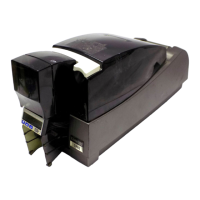2-18 Theory of Operation
Magnetic Data
The method for recording information on a magnetic stripe is called two-
frequency, coherent phase encoding (also known as F/2F). Although the name is
complex, the concept is simple: two signals are merged together and written as a
single signal. The significance of this format is that a timing signal is embedded
in the data stream (called self-clocking data). This method allows the data to be
read properly regardless how fast or slow a person swipes the card past a read
head.
The clock signal is evenly spaced pulses that are recorded for the whole length of
the stripe. The binary data is written between each of the clock pulses. These two
signals are merged together into a serial data stream and sent to the magnetic
head as an alternating current of varying frequency.
In the example below, the binary data to be written to the card is “011001.” When
this is merged with alternating clock pulses, the result is “1011111010111.” To
write this merged data string to the magnetic stripe, the polarity of the magnetic
head is reversed when a “1” is in the data stream, and left unchanged when a “0”
is in the data stream.
When this information is read back from the magnetic stripe, the current in the
magnetic head appears as alternating pulses. This is shown as the bottom graph
in the figure above.

